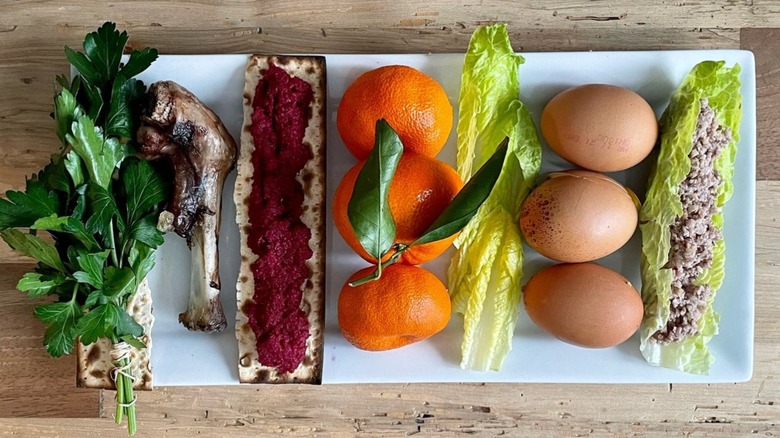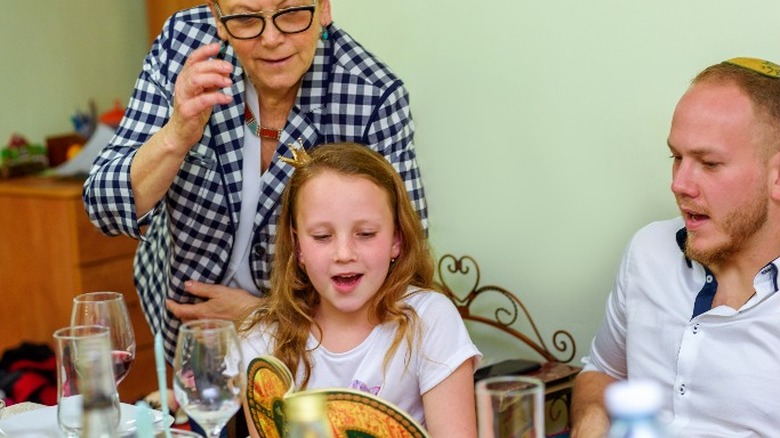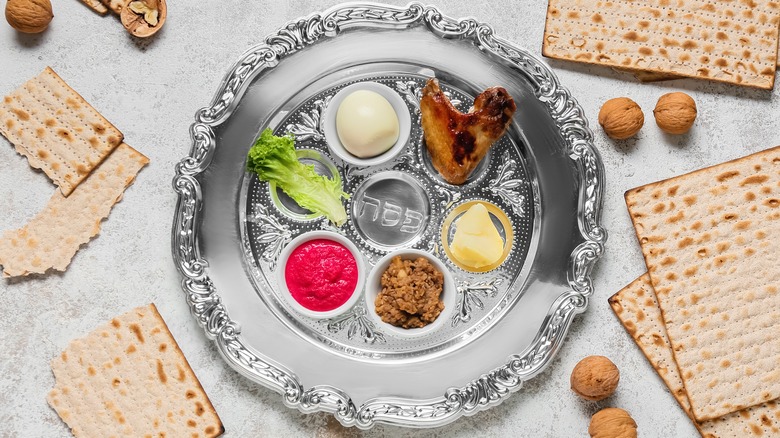The Urban Legend Behind The Orange On The Seder Plate
Passover revolves around the retelling of the story of the Jewish people's escape from slavery in ancient Egypt (via My Jewish Learning). Combining the Jewish appreciation for festive dining and storytelling, the "Seder," as the storytelling ritual is known, takes place at the dinner table, amid multiple generations, who are encouraged to recline in their seats in recognition of having the freedom to do so (per Chabad).
That being said, the Seder is meant to be entertaining, thought-provoking, and satisfying. That goes a long way toward explaining why the story is told in mixed media format, including spoken narration, call-and-response, singing, prayer, and props that are actually food. There is also the drinking of four glasses of wine and the eating of said props. Each of the traditional Seder Plate elements symbolizes some integral part of the story. Over the years, however, more progressive Jewish families have been introducing new ones with the goal of highlighting aspects of the story that, in retrospect, may have been marginalized by the traditional telling.
For example, "Miriam's Cup" celebrates a woman without whom the story would not have happened. Another is the orange on the Seder Plate, which is actually the subject of a rather unpleasant legend, as well as a symbol of love and acceptance. Let's unpeel that, shall we?
The real story of the orange on the Seder Plate
Dr. Susanna Heschel, a professor of Jewish studies at Dartmouth College, and the daughter of the late esteemed Jewish theologian, Rabbi Abraham Joshua Heschel, knows the real story of why some Jewish people have been putting an orange on their Seder Plates. That's because she is the one who created said story more than 30 years ago. In an essay Dr. Heschel wrote for The Forward, she tells of how she first started placing oranges on the table during her Seders in the early 1980s.
While mindful of tradition, Dr. Heschel noted, "Jews have often added new customs to Passover." This new custom delivers sustenance to quell rumbling tummies, which might distract from the immersive story-telling experience that is the Seder. At the same time, the orange symbolizes those whose role in the Jewish experience has been marginalized by tradition — including the adopted, the converted, and the neuro-divergent — all of whom help make the Jewish community as vibrant as it is.
The juicy sweetness of the orange is meant to remind us of that vibrancy, while the segments stick together as part of a whole but are also capable of standing alone. The seeds, which represent intolerance and hate, are bitter and are spit out in repudiation thereof.
The urban legend of the orange on the Seder Plate
In an essay that she wrote for The Forward in 2013, Dartmouth professor Dr. Susanna Heschel recounts the origins of the modern-day orange on the Seder Plate. She also went on to recount the urban legend version, in which a man from Florida (the orange capital of the U.S.) supposedly denounced Dr. Heschel's teachings by saying something to the effect that a woman has no more right to be teaching Judaism than an orange has a right to be on a Seder Plate.
It's a powerful tale because it does sound like it really could have happened. Except it didn't. Moreover, it has gone on to generate mythical variations of its own, including one in which the man didn't reference an orange, but a crust of bread. But that would have meant that Dr. Heschel placed a crust of bread, not an orange, on the Seder Plate. And that never happened. Nor could it have, given that traditionally, Jewish people not only eat no bread during Passover's eight days but literally go out of their way to get rid of all bread they may have had in their homes (via Time). Moreover, traditional Jewish people will not even eat on plates that ever so much as touched bread; they break out a whole separate set just for Passover. So, it is Dr. Heschel's story of how the orange came to be on the Seder Plate that is more believable.


